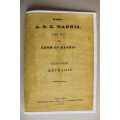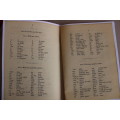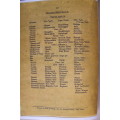


Rev. H C Knudsen - NAMA- A.B.Z. Kannis, Gei *Hu- *Ze Khom-Ei-Kannis.
New
Shipping
Standard courier shipping from R30
R30 Standard shipping using one of our trusted couriers applies to most areas in South Africa. Some areas may attract a R30 surcharge. This will be calculated at checkout if applicable.
Check my rate
Check my rate
Ready to ship in
The seller has indicated that they will usually have this item
ready to ship within 15 business days. Shipping time depends on your delivery address. The most
accurate delivery time will be calculated at checkout, but in
general, the following shipping times apply:
Standard Delivery
| Main centres: | 1-3 business days |
| Regional areas: | 3-4 business days |
| Remote areas: | 3-5 business days |
Get it now, pay later
Seller
Buyer Protection
Product details
Condition
New
Location
South Africa
Bob Shop ID
614005706
Here below detail of the original copy. I have made copies in colour. The booklet you will buy here, is a colour copy of the original.
FIRST (and only) edition, comprising the very first language primer for the Nama language in South West Africa. The sub-title apparently translates as "Shouting Together and Reading Book". This spelling and reading book includes vocabularies with an English translation, and part of a catechism; viz., the Ten Commandments, part of St. Augustine's creed, the Lord's Prayer, &c."
A copy was sold on Antiquarianauctions 30: Sold for: $4,988
String bound in the centre with the original string. This copy is in good condition.
OCLC records only 5 additional copies of this title: NYPL, University of Natal Library, Universiteit Leiden, Univ of Cape Town Library, and another in South Africa.
Hans Christian Knudsen (March 18, 1816 - May 4, 1863) was a Norwegian missionary and painter. He was a pioneer Rhenish Missionary pioneer and scholar of Khoekhoe.
Knudsen was born at Bergen, Norway. He was the son of Frederik Thomas Knudsen and Annelis Johanne Marie Lie. He finished his training as a painter and lithograph at the Bergen Academy of Art and Design. He joined the Rhenish Missionary Society in Elberfeld-Barmen in 1836, and upon completing his training at the missionary institute was dispatched in 1841 to South West Africa to further the work of Heinrich Schmelen (17761848) who had been based at what is now Bethanie, Namibia.
After a short sojourn with Schmelen in Komaggas in Namaqualand (at the time called Little Namaqualand), Knudsen took his post in Bethanie in November 1842. Though he still needed an interpreter to communicate in Nama, he built enough rapport to be trusted with codifying tribal laws previously held in oral tradition to reduce arbitrary caprices in their execution. The resulting code was adopted as tribal law in October 1848. The Nama in Berseba and Rehoboth adopted the same code with amendments. Although some provisions proved unworkable, the core of the legal corpus remains in force today and provided a foundation for agreement among the three subtribes based in the above towns and for further cultural development.
Knudsen traveled through the tribal territories around Bethanie and Berseba, writing their observations in diaries and reports. Knudsen drew and painted portraits of distinguished chieftains, scenes of village life, and ordinary Herero in Windhoek. He was the first European artist based in South West Africa. His works were published in the mission magazine and are currently displayed in the mission archives. The only works of his remaining in Southern Africa are two portraits of Khoikhoi at Stellenbosch University.
Knudsen's diaries attest to his already studying in depth the language and customs of the Nama, Damara (Herero), and San peoples. His findings conflict with those of the explorer Sir James Edward Alexander, especially in the 1844-1845 entries where he claims the Nama to be descended from the Ten Lost Tribes of Israel.
Oorlam Nama under chief Paul Goliath eagerly recruited his ministry and he established the mission of Gudbrandsdalen to serve them in an area that reminded him of his childhood home in the eponymous region.
Knudsen rebuilt in 1842 the stone cottage Schmelen had built in Bethanie in 1814 to reside until his 1834 departure, which had been razed in the interim. Still known as the Schmelen House, it has long been considered the oldest stone building in existence and the second ever built by Europeans on Namibian soil. The first, built by Wesleyan missionaries in 1806 in Warmbad, was destroyed by Jager Afrikaner, father of Jonker Afrikaner.
Knudsen took leave to Europe in June 1847, presenting his work at missionary festivals and ultimately publishing Gross-Namaqualand("Greater Namaqualand", Barmen, 1848). On a visit to Bergen, he married Petronella Christiansen.
On his return to Bethanie in 1849, he found his congregation abandoning Christianity and joining the raids of Jonker Afrikaner against the Herero. Boycotting the raids in protest, he was banished by the chief of Bethanie.
Bitterly disappointed, Knudsen roamed around missions in the Northern Cape, ending up in Tulbagh in 1852. Struggling to adapt and cope with his wife becoming mentally ill, he left the ministry in 1854 and returned to Norway. His wife died in an asylum and he made a meager living as an itinerant preacher dying at Hattfjelldal, Norway. His two sons were adopted and raised by family members.
Knudsen's first publication was Nama A.B.Z. kannis (Cape Town, 1845), a short book of prayers and readings with a glossary, English translation, and part of the catechism, the Ten Commandments, and other parts of the Holy Scriptures. Around the same time, he published an alphabet of sorts in the Nama language. Copies of both appear in the Grey collection in the National Library of South Africa Cape Town campus, complete with Knudsen's handwritten notes. The same collection includes his handwritten Südafrica: Das Hottentot-Volk: Notizzen ("South Africa: The Khoikhoi: Notes"), Stoff zu einer Grammatik in der Namaquasprache ("Fundamentals of Grammar in the Nama Language"), and Namaquasprache. These cover the geography and ethnography of Great Namaqualand as well as Khoekhoe syntax.
Knudsen's translation of the Gospel of Luke and the two aforementioned Cape Town publications were key sources for RMS Inspector J.C. Wallmann's Vocabular der Namaqua Sprache nebst einem Abrise der Formenlehre derselben ("Vocabulary of the Nama Language and Fundamentals of its Grammar," Barmen, 1854). His Gospel of Luke in Khoekhoe was published in Cape Town with some hymns in 1846 after a few productive years of learning the language with the help of two Nama translators. Though slightly proofread on spelling from the earlier publications, Wallmann's copy was rendered so meticulously that it was virtually free of printing errors, and Wilhelm Bleek described it in 1858 as "so far the best and most reliable source on [Khoekhoe]". Though somewhat rigid, it rendered idioms accurately. (Wikipedia)


